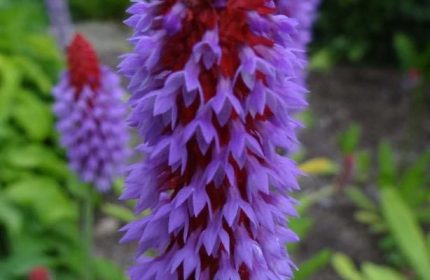Gardening trends for 2023 – experts make their predictions
Health and wellbeing, saving money, sustainability and climate change are likely to be in vogue.
Planet-friendly gardening is on the cards for 2023 as gardeners ditch peat, create alternative lawns and encourage wildlife onto their patch, using sustainable techniques to improve their soil and conserve water.
View this post on Instagram
Restorative gardens will take centre stage at the 2023 RHS Chelsea Flower Show, as designers offer ideas on how gardening can contribute positively to our health and also help the environment. There’s also going to be a big push on community gardening.
Take a look at some of the gardening trends predicted for 2023.
Wildlife planting
“As environmental concerns increase, particularly among young people, we’ll see more wildlife-friendly gardening using recycled products, organic fertilisers and peat-free or homemade compost in 2023,” predicts Chris Collins, head of organic horticulture at charity Garden Organic (gardenorganic.org.uk).
View this post on Instagram
“I think more gardeners will follow the example of a number of councils and plant a more wildlife-friendly garden to attract pollinating insects.
“Gardeners may also experiment with companion planting and rethinking their attitude to ‘weeds’, taking a more relaxed approach and acknowledging their important role as sources of pollen.”
Environment and climate change
“Climate change will see gardeners review the types of crops they grow to more closely align with the climate in their part of the country,” Collins suggests.
“Heat and drought-tolerant plants will be bought, water-saving and the use of water butts will increase and planting techniques will change to ensure plants can withstand high winds and flooding.”
View this post on Instagram
Sarah Squire, chair of Squire’s Garden Centres (squiresgardencentres.co.uk), predicts: “Customers may be looking at investing in drought-tolerant, heat-loving plants that can weather the increase in temperatures we are experiencing and that can look after themselves.
“Many offer long-lasting colour in the garden. Inspiration can be drawn from Mediterranean garden style, successfully combining drought-resistance plants with striking colour. Lavender, rosemary, thyme and a host of other herbs fit the bill.”
New heights for houseplants
View this post on Instagram
The trend in houseplant popularity will continue, with more exotics such as such as Cymbidium and Dendrobium orchids and scented-leaf varieties performing better in cooler homes, the RHS predicts.
More composting
In August the Government announced that the sale of peat for use on private gardens and allotments will be banned in England from 2024, in a bid to protect the UK’s already severely degraded moorlands.
People will seek out environmentally-friendly, wood-based compost alternatives to peat-based bagged compost, the RHS advises.
Seaweed and biochar feeds could be used to complement these alternatives, while comfrey and winter beans can be grown as green manures to help fix nitrogen and other nutrients into the soil and provide habitat and food for wildlife.
View this post on Instagram
“More gardeners will switch to producing their own compost,” predicts Collins.
“With the cost of living crisis, gardeners will be looking to save money and a compost heap recycling fruit and vegetable peelings, garden clippings and paper/cardboard waste will save money, reduce environmental damage from digging and transporting peat and bags of compost and produce an excellent soil improver.”
Tighter spending
“Environmental concerns and tight purse strings are also likely to stop gardeners reaching for chemicals to tackle common garden pests, Collins predicts.
View this post on Instagram
“Instead of buying expensive bug sprays there will be a move to using more barriers and traps, companion planting to deter bugs while at the same time allowing some natural predators to flourish as they provide food for important pollinators,” says Collins.
Squire adds: “I think people will want to make thrifty choices, looking for great value plants that are proven to do well. This is where the Royal Horticultural Society’s Award of Garden Merit (AGM) scheme is so useful. An AGM is given only to those varieties which are proven to be a great example of their plant type and to perform well in the garden. So an AGM plant is a good and reliable choice.”
Changing lawns
Gardeners will be saving time by giving up parts of their lawn to pollinators and other garden wildlife, letting borders grow long or looking into lawns that require less water and maintenance, the RHS predicts.
This includes tapestry lawns made up of low-lying, intertwining flowering plants such as yarrow. Many breeders are focusing on drought-tolerant varieties for lawns, including tall fescue grass and micro-clovers, which mean these lawns stay green without watering even in very dry areas.
Move towards hardier vegetables
View this post on Instagram
Perennial veg such as Jerusalem artichokes, Daubenton kale and ‘Nine Star Perennial’ broccoli will increasingly be planted due to their sustainable nature and ability to withstand weather extremes, says Collins.
Trending styles
View this post on Instagram
“The colour for 2023 is terracotta, as well as earthy tones like sage green, beige and cream. These evoke warmth, excitement and amusement,” says Mark Lane, BBC Gardeners’ World presenter, designer and Stannah (stannah.co.uk) gardening expert.
“There is also a real trend towards everything Greek with white-washed and stone walls, sculptures, archways and tall trees with pops of colour from agapanthus and cyclamen. Hand-crafted objects and furniture will be used to create the romantic beauty of Greece.”
“A trend that has never left us is the cottage garden look – cleverly planted to include flowers, herbs and fruits – not only a nod to bygone times but a smart way of gardening,” says Squire.
View this post on Instagram
“Many cottage garden plants are great for encouraging wildlife. The more variety of flower shapes you grow the wider the variety of bees and butterflies that will be attracted to your garden. And they come back year after year, making them a wise choice for your wallet.”
This all blends with the vogue for nostalgia, as 1970s designs are reformatted for 2023 living, Lane notes.
Gravel gardens
View this post on Instagram
There will be a large push towards gravel gardens, Lane reckons. Once established, they will require 80% less maintenance.
“With more of us taking note of water shortages, drought and heat-tolerant plants that grow happily in gravel gardens will be seen everywhere.
“The knack will be limiting colours and plants to create that calm oasis. Picking up on the Greek vibe, blue will be seen as an accent colour, whether in soft furnishings, plants or outdoor paint.”
Urban chic
View this post on Instagram
“New collections of seeds and plants will focus on small urban gardens as well as larger outdoor spaces. Soft pastel colours will be mixed with vibrant, bold colours – soft pinks, blue and mint green will alternate with vivid accents from bright orange to scarlet,” says Lane.
Planting trees
View this post on Instagram
The Queen’s Green Canopy initiative has been extended until March 2023, which may continue the tree-planting trend in gardens and the wider community, Squire predicts.
“Even the smallest of gardens can be part of the nationwide programme while taking advantage of the nation’s official planting season of October to March,” she says.
Restful style
View this post on Instagram
Restful and restorative places will be a key theme again for next year, with soothing colours and cosy textiles, says Lane. “On-trend natural colours will also blend into nature, blurring the two. This is all about that true connection with the natural world.”
“Boutique-style garden furniture will be seen with plush soft furnishings, but again in neutral colours. To get the look right just think what furniture you like for indoors and find similar pieces for outdoors,” he adds.
“Patterned outdoor tiles will be on trend, with symmetrical designs playing centre stage, adding a strong design element.”
Techy gardening
View this post on Instagram
Apps and social media are becoming even more important as gardeners share what’s happening on their patch, participate in courses and workshops digitally and are prompted into action to plan and plant using apps, the RHS notes.




















